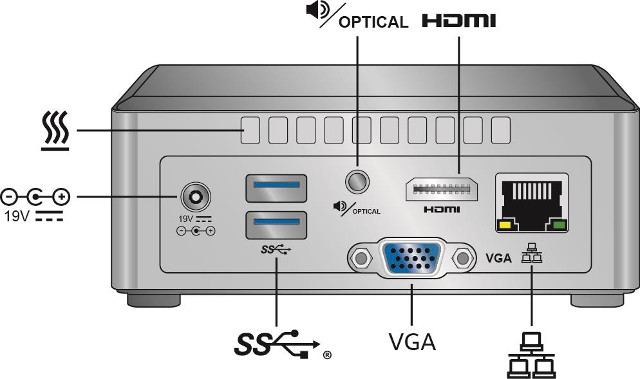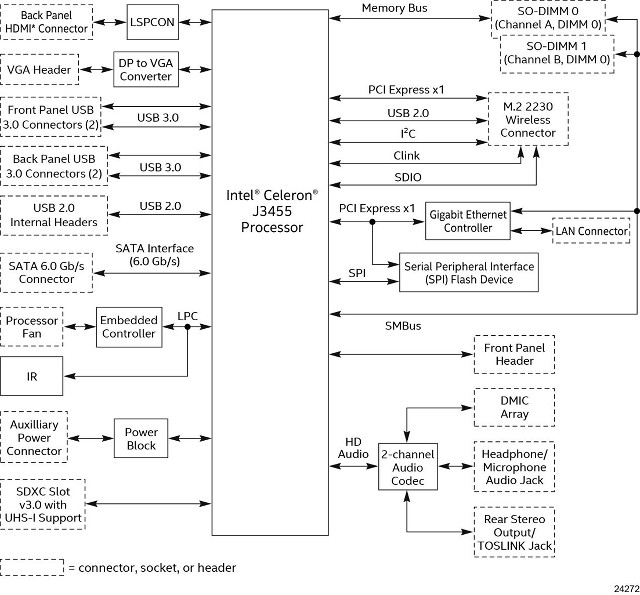Intel unveiled Intel NUC6CAYS & NUC6CAYH NUCs to be powered by Intel Celeron “Apollo Lake” Jxxx processors, but at the time we did not have the full technical specifications. The company has now published a 66-page technical product specification for NUC6CAYB board used in both mini PCs.
 Intel NUC Board NUC6CAYB specifications:
Intel NUC Board NUC6CAYB specifications:
- SoC – Intel Celeron J3455 quad core processor @ 1.5 GHz to 2.3 GHz (burst) with 12EU Intel HD graphics 500 @ 250 to 700 MHz supporting DirectX 9.3/10/11.1/12, OpenCL 1.2, OGLES 3.0, OpenGL 4.3 (10W TDP)
- System Memory – 2x DDR3L-1600/1833 SO-DIMM supporting up to 8GB DDR3L-1866 in total
- Storage – 32GB eMMC flash (Sandisk, Hynix or Samsung depending on your luck), 2.5″ SATA3 bay for hard drives up to 9.5mm thick, SDXC slot with UHS-I support
- Video Output –
- HDMI 2.0 (4K @ 60 Hz) with HDMI CEC via MegaChips MCDP2800-BCT DisplayPort 1.2a to HDMI 2.0 Level
Shifter/Protocol Converter - VGA via ITE IT6516BFN DisplayPort to VGA bridge
- HDMI 2.0 (4K @ 60 Hz) with HDMI CEC via MegaChips MCDP2800-BCT DisplayPort 1.2a to HDMI 2.0 Level
- Audio – Up to 7.1 channels via HDMI, 3.5mm headset jack, 3.5mm rear speaker/TOSLINK combo jack; digital microphone (DMIC) array; Realtek ALC283 HD Audio codec
- Video Capabilities
- Video Decode – H.265/HEVC @ Level 5.1, H.264 @ Level 5.2, MPEG2, MVC, VC-1, WMV9, JPEG, VP8 and VP9 formats
- Video Encode – H.265/HEVC @ Level 4, H.264 @ Level 5.2, JPEG, MVC, VP8 and VP9 formats
- Content Protection – High-Bandwidth Digital Content Protection (HDCP) 1.4/2.0 and PAVP 2.0.
- Connectivity – Gigabit Ethernet (Realtek RTL8111HN), Intel Wireless AC-3168 M.2 module for 802.11ac 1×1 WiFi up to 433 Mbps and Bluetooth 4.2 with internal antennas
- USB – 2x USB 3.0 ports on the front panel (yellow one for charging other devices even when the NUC is powered off), 2x rear USB 3.0 ports, 2x internal USB 2.0 ports via header; 1x USB port reversed for M.2 2230 type E module
- Expansion – 1x M.2 Module supporting M.2 2230 cards (key type E) (prepopulated with Intel Dual Band Wireless-AC 3168 module)
- Misc – Consumer Infrared (CIR), Kensington key lock hole, hardware monitoring subsystem based on ITE IT8987D embedded controller (voltage, temperature, fan control)
- Power Supply – 12 to 19V DC input
- Dimensions – Board: 101.6 x 101.6mm; NUC: 151 x 111 x 51 (plastic casing with inner metal structure)

The board will be used in NUC6CAYH Kit with power adapter, no memory, no eMMC, no OS, as well as NUC6CAYS Kit with power adapter, preinstalled with 2GB 1600MHz SO-DIMM, and 32GB eMMC with Microsoft Windows 10 Home.
The specifications mention that Microsoft Windows 10 Home and Microsoft Windows 10 Pro operating systems are supports, and that “other operating system (OS) support may be available”. It’s very likely Linux be supported, and if you plan to run Linux the barebone kit is probably more suitable albeit you’ll lose the eMMC flash, and instead would have to install the OS on a SATA SSD or hard drive.
The other things that’s unclear right now are the price and availability for the new NUCs, but the wait should be almost over.
Via Liliputing and NUC Blog

Jean-Luc started CNX Software in 2010 as a part-time endeavor, before quitting his job as a software engineering manager, and starting to write daily news, and reviews full time later in 2011.
Support CNX Software! Donate via cryptocurrencies, become a Patron on Patreon, or purchase goods on Amazon or Aliexpress




